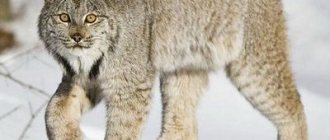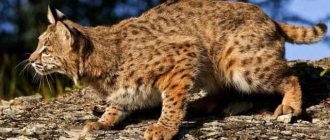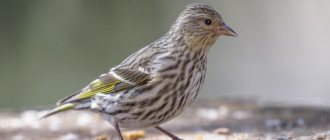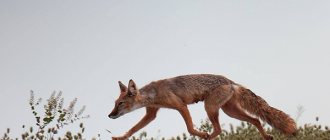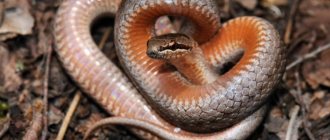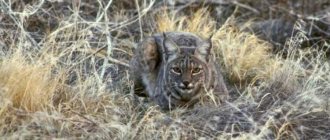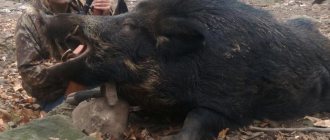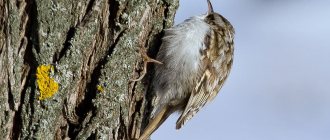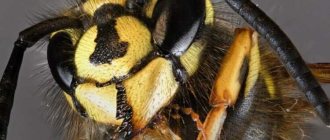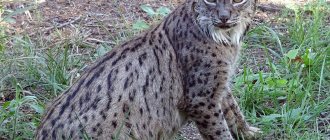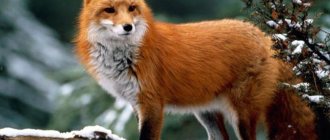Lynx is a predatory mammal from the cat family. The genus of lynx belongs to the subfamily of small cats and includes four living and one extinct species. Scientists believe that this is one of the most ancient genera of cats: the evolution of the lynx from the first ancestors to modern varieties lasted about 4 million years.
Starting from 2022, in order to attract public attention to the animal, it was decided to celebrate Lynx Day. Every year on June 11, employees of zoos and zoos introduce visitors to the habits and characteristics of this predator and share photos and videos of their pets on social networks.
Characteristics and description of the animal
The lynx is nocturnal: during the day it sleeps in a shelter, and at dusk it goes hunting. Before an attack, the lynx tracks down a potential victim and sets up an ambush. When prey approaches, the predator makes a lightning-fast jump, developing speeds of up to 40 km/h. If the attack is unsuccessful, the lynx retreats and does not pursue the fleeing animal.
A lynx's den can be located in crevices, between stones, in recesses under the inverted roots of a fallen tree. Lynx often settle in abandoned burrows of foxes or badgers.
The animal is not aggressive in nature and prefers to avoid meeting people. It is dangerous only in cases where people pose a threat to their offspring.
Due to anatomical features, the lynx, like other small cats, is not capable of roaring. To communicate and exchange information with other individuals, it growls, hisses, and in case of danger, makes a sound similar to a squeal or screams protractedly. When communicating with cubs, the female can purr like an ordinary domestic cat.
What sounds does a lynx make?
The lynx, like all representatives of the order of carnivores, plays an important role in the selection of species lower in the food chain. The population size in the wild is regularly monitored, and in those regions where the species has been exterminated, attempts are being made to repopulate and adapt the animals.
What does it look like
The appearance of the lynx has certain features. A short massive body on high legs, a short tail, a small head - all this distinguishes it from its relatives from the cat family. The most striking and memorable feature is the black tassels on the ears.
The external characteristics of the animal include the following:
- The lynx has a short muzzle with narrow jaws and a large, wide nose;
- on the sides of the head the hair is longer and forms peculiar sideburns;
- the eyes are large, with a round pupil;
- There are four toes on the front paws and five on the hind paws.
The lynx's color is spotted, the belly and the inside of the paws are lighter than the back. In the summer months, the animal's body is covered with short fur of a reddish or brownish hue. Before the onset of winter, the lynx molts again. Winter fur is longer and the hairs are silver-gray, dark gray and dark brown.
Fur
Information about the lynx would not be complete without mentioning the value of the fur of this animal. Due to its density, resistance to external influences and attractive appearance, lynx fur ranks third among the most expensive furs in the world, with the most expensive part of the skin being the abdominal part. The Scandinavian and Siberian varieties of the animal that live in the northern regions are valued above others.
The high cost of lynx fur products is explained by the limited amount of raw materials: currently, the extraction of skins is permitted only in Canada.
How many years do they live
The average lifespan of lynxes in the wild is 15-17 years. In captivity, animals live up to 25 years.
In their natural habitat, lynxes often die during attacks by enemies - wolves and wolverines. Sometimes the cause of death is injuries received from other cats (jaguars, pumas, snow leopards) during fights over killed prey.
WOLVERINE
Peculiarities
The domestic lynx differs from its ancestor in many qualities. The domestic specimen was produced by crossing a small wild animal with an ordinary cat. The only condition for this was the selection of a color similar to the natural color of the forest beauty.
The caracal is considered a domestic lynx. But it also requires careful care, certain conditions and constant care from the owners. A spacious enclosure is needed.
We must not forget that keeping a lynx within the walls of a house is not an easy task, and additional considerable financial costs will be required.
Particular attention should be paid to the diet: meat, fish, bones and no dry food. It is important to systematically comb the animal, since when licking the fur, the lynx can swallow it, choking on it.
Many people are interested in the question: is a lynx dangerous at home? It's up to you to decide: a wild lynx is a predator, an artificially bred one is also a predator, although its natural instincts are hidden quite deeply. And predators are always dangerous.
The lynx is the keeper of secrets and symbolizes truthfulness, impeccability, openness, silence and many other qualities of clairvoyants.
And if you choose the lynx as your totem, beware of deceiving people’s trust, watch your words, choose expressions with caution.
Types of lynx: photos with names
The classification distinguishes four types, each of which combines several varieties.
Common lynx
The scientific name of the species is Lynx lynx . This is the most numerous group of animals in the genus, distributed on the Eurasian continent. Due to its habitat, the common lynx is often called the Eurasian lynx. There is still no clear, generally accepted division into subspecies. The most extensive list, consisting of 10 varieties of the common lynx, is presented in the reference book by V. Heptner and A. Sludsky. Researchers distinguish such subspecies as Amur lynx, Balkan, Caucasian, Baikal, European, Turkestan and others.
The common lynx population is unevenly distributed across the continent. The highest population density is observed in Belarus, in the countries of the Scandinavian Peninsula, in the Baltic states, and in the eastern part of the Siberian region of Russia.
Canadian lynx
Lynx canadensis
A relatively small species of animal. The range extends to forested regions of Canada and the northern states of the United States. For a long time, the Canadian lynx was considered a subspecies of the common lynx. In the modern version of the classification, it is recognized as a separate taxon and is divided into two groups.
Lynx Iberian
Lynx pardinus
Also known as Spanish or Iberian. The historical range of the animal covered the entire Iberian Peninsula and reached the south of France. Currently, two local populations of Iberian lynx have been established in the south and southeast of Spain. Due to a sharp decrease in numbers, the species was listed in the International Red Book with the status of “endangered species”.
Red lynx
Lynx rufus
The smallest of the lynxes: the size and weight of an adult are almost half that of an ordinary one. It lives in the central and southern states of the USA, almost throughout Mexico. You can distinguish the dwarf lynx from other relatives by the color of the tip of the tail: usually it is completely black, while the red lynx has a small white spot on the inside.
Color mutations are quite common among red lynxes: albinos or melanists periodically appear in normally colored parents.
Dimensions
All of the listed varieties have different habitats, habits and food preferences, and also differ in weight and size. Below are the averages for adults of all species.
| Name | Length | Height | Weight |
| Ordinary | 130 | 70 | 25 |
| Canadian | 117 | 65 | 14 |
| Pyrenean | 100 | 60 | 12 |
| Redhead (red) | 80 | 35 | 11 |
The largest lynx in the world lives in Yakutia. The Far Eastern lynx is considered a variety of the common lynx and differs from other subspecies by the predominance of various shades of gray in color.
Population status
Let's look at the status of the lynx population in individual countries. At one time, such animals settled en masse in wooded areas in Germany. However, by 1850, representatives of the species were completely exterminated by hunters in pursuit of valuable fur and meat, which were considered a delicacy. Where do lynxes live in this country today? In the 90s of the last century, such predators were reintroduced into several reserves. Today, the largest populations are concentrated in the German national parks Harz and Bavarian Forest.
The common lynx was also exterminated in France and Switzerland. At the beginning of the last century, the government of these countries decided to restore the large population of the animal. Such predators were introduced into local protected areas. This is where their migration to Slovenia and Austria took place.
The situation on the Balkan Peninsula is deplorable. Thus, in the territory of Albania, Serbia, Greece and Macedonia today there are only a few dozen of these beautiful animals left.
Lynx are the most numerous in Russia. About 90% of the entire world animal population is concentrated in domestic spaces. You can often find a predatory cat in the forests of Siberia, near the western borders of the country and on Sakhalin.
A fairly large population of such animals is observed in the Carpathian Mountains. According to statistics, more than 2,000 representatives of the species live in territories from Romania to the Czech Republic.
A wide population of lynxes is also found in Scandinavia. According to researchers, about 2,500 of these predators live in Finland, Norway and Sweden.
Where do they live?
The lynx's habitat covers North America, northern and central Europe and Asia. A few local populations are found in Germany, Italy, Spain, and the countries of the Balkan Peninsula. The lynx is found in the Caucasus, Turkey, Pakistan, Iraq and Iran.
Where live
The most suitable habitat for lynxes is dense coniferous forests. The highest population density is observed in the taiga. In such natural zones as tundra, forest-tundra, forest-steppe, where open areas predominate, the animal is much less common.
Observation of predators living in the Stolby, Bashkiria nature reserves, and the Voronezh Natural Biosphere Reserve made it possible to establish that each adult occupies a forest area of up to 200 square meters. km. If there is enough prey, the plots may be smaller. The lynx leaves its habitat only in exceptional cases: in the absence of food or during a natural disaster.
Habitats
The common lynx is a northern species of predatory cat. In Scandinavia, representatives of the species inhabit vast territories, right up to the Arctic Circle. A few centuries ago, the animal was widespread throughout Europe. However, in the middle of the last century, the predator was almost completely exterminated. Nowadays, attempts are being made to restore former populations in protected areas.
Where do lynxes live in the vastness of Russia? In domestic latitudes, the predator can be seen in wooded areas remote from civilization. Representatives of the species are distributed in areas from Sakhalin to Kamchatka. On the territory of neighboring states, lynx is found in the Carpathians, mountainous regions of Central Asia, and the Caucasus.
Representatives of the species prefer to inhabit the taiga and occupy territories in mountain coniferous and mixed forests. Occasionally, the predator is found in areas with bushes and low-growing vegetation. The areas where lynxes live usually have dense thickets of young trees. Here predators set up their lairs to raise their young.
How does it move?
The lynx is a fairly agile and hardy animal. She climbs trees well, climbs up mountain slopes, and can cover distances of up to 30-40 km per night in search of prey. Lynxes are one of the few cats that are not afraid of water and are excellent swimmers. During an attack, they are capable of jumping up to 4 m.
Another feature of the lynx is that when walking, its hind paws step into the tracks left by its front paws, while the animal does not move in a straight line, but in a winding snake.
What does it eat?
The diet largely depends on the variety. Small lynxes eat rodents, birds, and hares. Larger common lynxes attack wild boars, young moose, roe deer and deer.
Every day the animal needs to eat up to 2 kg of meat. The lynx covers the uneaten remains of carcasses with fallen leaves or snow. Very often, poorly hidden prey is found by other predators.
MANUL
Nutrition
The lynx is a highly specialized predator. In the autumn-winter period, the basis of its diet consists of hares and roe deer (sometimes up to 70%), at other times it also hunts musk deer, various birds (hazel grouse and grouse), mouse-like rodents, and sometimes preys on young deer, wild boar and even moose. Hunting through deep snow and crust, the lynx can cope with large adult animals, but on occasion it also catches squirrels, martens, sables, weasels, raccoon dogs and foxes. This representative of the cat family usually hunts at dusk. Contrary to popular belief, a lynx never jumps on its prey from a tree, but prefers to watch for it for hours, and sometimes for days, hiding in some place with a good view. Thanks to its camouflage coloring and complete immobility, it is very difficult to notice, but thanks to its extremely fine hearing and surprisingly sharp vision, it detects the victim from afar. The lynx's throws are lightning fast and almost always accurate, and the fight even with a large animal does not last long: its teeth and claws are huge and very sharp.
How do they reproduce?
The breeding season for lynxes occurs in February. Animals living separately change their habits: males and females begin to meow loudly, attracting individuals of the opposite sex. Animals that have formed a pair during the mating season show each other signs of attention: pushing their foreheads, rubbing their noses, licking their fur.
After mating, the pair separates. The female begins preparations for the appearance of offspring. She sets up a secluded den, lining it with dry grass, wool and bird feathers. Pregnancy in lynxes lasts a little more than 2 months, after which 1 to 4 blind and deaf kittens are born. Newborn lynx cubs weigh about 300 grams and differ from adult animals in color and the absence of tufts on their ears. For the first 8-10 weeks, the cubs feed only on mother's milk. At 3-4 months, the babies begin to eat meat brought by the female. At the same age, they leave the hole for the first time and go on their first hunt under the supervision of their mother.
The cubs live with the female until the next mating season. If the female fails to become pregnant, the offspring remain with her for another year. If pregnancy occurs, the lynx leaves the kittens, which continue to live and hunt together for some time.
Reproduction
Reproduction takes place every year, from February to April. The female's estrus lasts about three days per season. The male and receptive female spend several days together and copulate many times a day. After the female ends her heat, the male leaves her and looks for another. The female has only one partner per season.
Gestation lasts from 67 to 74 days, with cubs born in May. The interval between matings depends on the success of the previous season. Females without young will mate every year, while females with young will mate approximately every 3 years. As a rule, a female gives birth to 2 to 3 lynx cubs. Newborns weigh from 300 to 350 g and depend on the nutrition and protection of the mother. They are weaned at 4 months and become independent at 10 months. Sexual maturity in females occurs at 2 years of age and continues until 14 years of age, while males mature after 3 years of age and are able to reproduce until 17 years of age.
Why does the lynx have a short tail?
All representatives of felines use the tail for maneuvering and quickly changing the direction of running while pursuing prey. The lynx spends most of its time in the trees and prefers to hunt from ambush, so the tail does not play such an important role for it. On the contrary, a long tail would prevent the animal from quickly moving along branches and hiding in hollows. This is most likely why the lynx is the cat with the shortest tail.
SNOW LEOPARD
Natural enemies
The main enemies of lynx in their habitats are wolves. To this day, it is not known why these predators show increased aggression towards these felines. They probably enjoy the tender, nutritious meat of such animals. Lynxes often manage to stay alive by climbing tree branches. Occasionally they become prey to wolves, which gather in large packs.
Unfortunately, human activity plays a decisive role in the decline of the lynx population. People are rapidly reducing the number of these beautiful animals. Perhaps this is why it is extremely rare to see such predators. After all, when they see a person, they tend to immediately climb a tree or hide in dense forest thickets.
Interesting facts about lynx
- In ancient Greek mythology, there is a legend about the Scythian king Linkh, who wanted to deceive himself for the glory of being a teacher of agriculture. Demeter, having learned about this, turned Linkh into a spotted cat, and the dagger thrown by the goddess after the fleeing animal cut off part of its tail. This is how the lynx with its shortened tail appeared in the animal kingdom. The scientific name of the lynx Lynx is taken from the ancient Greek language and is consonant with the name of the Scythian king. Translated, it means “red”.
- For a long time, the caracal (steppe lynx), which lives on the African continent and East Asia, was classified as a genus of lynx. However, genetic analysis showed that this species has a number of differences, and therefore caracals were classified as a separate genus.
- Lynxes have excellent hearing and sharp eyesight. In ancient times, they were credited with supernatural abilities, including the ability to see through objects.
- With the onset of cold weather, the lower part of the lynx's paws becomes covered with fur. Thick fur allows the animal to move through the snow without falling through.
